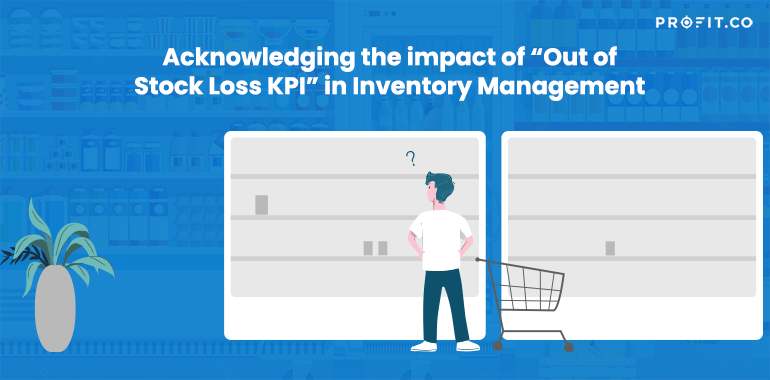Introduction
In the world of retail, there might be situations where you may feel like you are stuck between a rock and a hard place, this out-of-stock (OOS) situation is one such scenario where you might deal with a detrimental effect on both customer satisfaction and a company’s bottom line. To assess the financial impact of out-of-stock events, businesses utilize a key performance indicator (KPI) called Out-of-Stock Loss.
In this blog, we will explore the definition of Out-of-Stock Loss KPI, its importance, the formula used for measurement, and the overall impact on businesses.
Definition of Out-of-Stock Loss KPI
Out-of-Stock Loss KPI measures the financial impact incurred by a business due to the unavailability of products or stockouts. It quantifies the revenue that could have been generated if the out-of-stock situation had been avoided. By understanding this KPI, retailers gain insights into the financial losses caused by inventory management issues and can take appropriate measures to mitigate them.
It is fine to celebrate success but its more important to heed the lesson of failure
Formula for Calculating Out-of-Stock Loss
Here’s a real-life example to illustrate the concept of “out of stock loss”
Let’s say you operate an online electronics store and typically sell around 100 units of a popular smartphone model daily. Due to an unexpected surge in demand and a delay in restocking, you run out of stock for this particular smartphone model for three consecutive days.
During those three days, potential customers visit your website or contact your customer service, only to find out that the smartphone is out of stock. As a result, they are unable to make a purchase from your store and might choose to buy from a competitor instead.
Now, let’s assume that the average selling price of this smartphone is $500, and your profit margin on each unit is $100. Based on your historical sales data, you estimate that you would have sold 300 units during those three out-of-stock days.
To calculate the out of stock loss, you can use the following formula:

The average selling price per unit refers to the average price at which the product would have been sold if it had been available during that period.
Estimated Sales Revenue = Number of Units (300) x Average Selling Price ($500) = $150,000
Actual Sales Revenue = Number of Units Sold (0, as the product was out of stock) x Average Selling Price ($500) = $0
Out of Stock Loss = ($150,000 – $0) = $150,000
In this example, the out of stock loss amounts to $150,000. This indicates the potential revenue that was missed due to the unavailability of the product, which could have been captured if the stock was sufficient to meet the demand.
By monitoring such out of stock losses, businesses can identify the financial impact of stock shortages and take appropriate measures to minimize future losses, such as optimizing inventory levels, maintaining average inventory ratio and improving supply chain processes, or implementing safety stock strategies.
Start reducing revenue loss caused by stockouts now with Profit.co
OKR Examples to Minimize Out of Stock Loss
To determine the number of lost sales, businesses need to track instances where customers attempted to purchase a product but could not do so due to a lack of efficient stock. To track the stock better and foresee the loss, OKRs help you to measure your target better with intuitive results. Here is an OKR specially crafted for you to provide a general framework for addressing out-of-stock loss situations
Minimize Losses Caused by Out-of-Stock (OOS) Situations
Objective: Streamline the Ticket Management Process
Key Result 1: Reduce the number of out-of-stock incidents across all store locations from 50% to 20%
Initiative: Deploy a robust inventory management system that provides real-time visibility into stock levels across all store locations.
Key Result 2: Launch demand forecasting model to achieve 95% accuracy in predicting product demand
Initiative: Utilize advanced analytics techniques, such as machine learning algorithms, to develop a demand forecasting model.
Key Result 3: Decrease the average duration of stockouts from 5 days to 2 days
Initiative: Strengthen partnerships with suppliers to reduce lead times and improve product availability.
Impact of Out-of-Stock Loss on Businesses
Revenue loss
Out-of-stock situations directly impact a company’s revenue, as potential sales are lost. Customers may switch to a competitor’s product or delay their purchase, resulting in immediate revenue loss.
Customer dissatisfaction and loyalty
When customers encounter stockouts, their shopping experience is compromised, leading to frustration and disappointment. This can negatively impact customer satisfaction, loyalty, and overall brand perception.
Brand reputation
Consistent out-of-stock occurrences can damage a company’s reputation. Dissatisfied customers are more likely to share their negative experiences with others, potentially deterring future customers from engaging with the brand.
Supply chain efficiency
Out-of-stock situations indicate potential inefficiencies within the supply chain. Retailers must analyze the causes of stockouts, such as inaccurate demand forecasting, poor inventory management, or supply disruptions, to enhance their supply chain best practices.
Strategies to Mitigate Out-of-Stock Losses
Improve Demand Forecasting
Utilize data analysis and forecasting tools to accurately predict customer demand and ensure adequate stock levels.
Optimize Inventory Management
Implement inventory management systems that enable real-time monitoring of stock levels, automated reordering, and effective stock rotation.
Enhance Supplier Collaboration
Strengthen relationships with suppliers to improve communication and minimize delays or disruptions in the supply chain.
Implement Safety Stock
Maintain safety stock levels to buffer against unexpected demand spikes or supply disruptions.
Embrace Technology
Leverage advanced technology solutions such as RFID tagging, barcode scanning, and automation to streamline inventory management processes and reduce the likelihood of stockouts.
Conclusion
Out-of-Stock Loss KPI provides crucial insights into the financial impact of stockouts on businesses. By measuring and monitoring this KPI, retailers can identify how to improve material management, areas for improvement in their supply chain operations, enhance customer satisfaction, and ultimately mitigate revenue losses. Through effective demand forecasting, inventory management, and supplier collaboration, businesses can minimize out-of-stock occurrences, ensuring a positive shopping experience for customers and driving long-term success.

